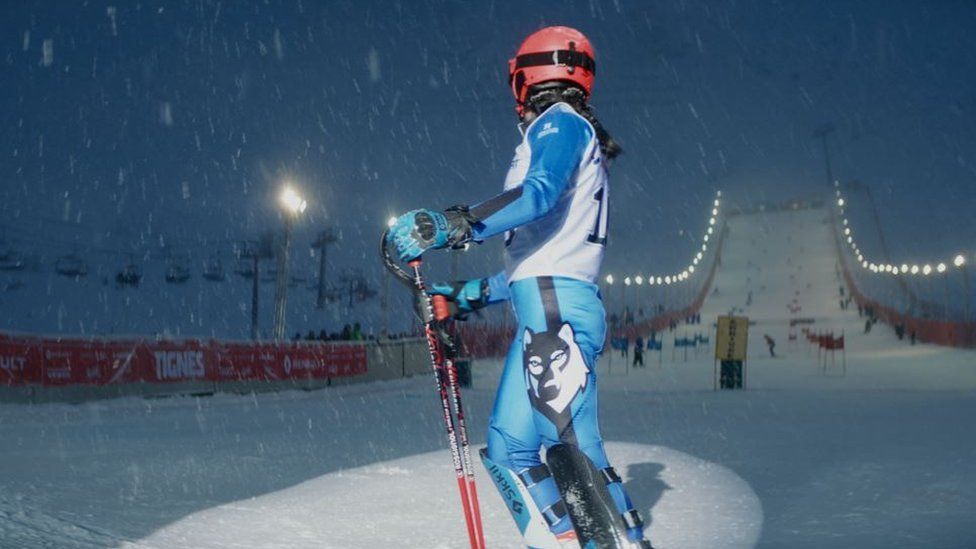Tech
Slalom: Film director 'was afraid' to tell story of abuse on the slopes – BBC News

A film that fictionalises the sexual abuse a teenager suffers at the hands of her skiing coach was only possible thanks to the #MeToo movement, its director says.
Slalom, set in a competitive ski club in the French Alps, is Charlène Favier’s first feature film. French actress Noée Abita plays Lyz, a 15-year-old girl who is accepted into a ski club that trains professional athletes up to an Olympic standard. She is groomed by her coach, Fred, played by In Bruges actor Jérémie Renier.
“I did indeed experience someone having a hold over me, but in another sporting context. I preferred to use fiction because it allowed me to take a step back from my own story. Around me, I heard many stories of young girls who had experienced what I talk about in the film. I have received many accounts.”


The director began writing the script in 2014, but the film wasn’t made until 2019 – by which time the #MeToo movement had begun and accounts of sexual abuse in sport were coming to light, including those of more than 250 US gymnasts against their former doctor Larry Nasser.
In 2020, French figure skating was also rocked by claims of decades of sexual abuse within the sport, following allegations by French champion Sarah Abitbol that she had been repeatedly raped as a teenager by her former coach.
“When I started writing the film in 2014, no one was really talking about all that. But I still wanted to denounce a taboo,” Favier recalls.
“I think that #MeToo was the first open door to all these stories to come out, and until I was able to shoot the film in 2019 this movement gave me strength and courage, because at the time I was afraid to tell the story.”


“I felt so alone, and no one wanted to hear it. It was hard to finance the film, people were telling me, ‘Oh, this is really interesting, it’s great writing but no.’ They didn’t want to hear it or face it either.
“So I think #MeToo gave me some power to keep going with the film, and when the recent sex scandals in the sports world broke, the film was finished. I knew it was an important story to tell.
“With Slalom, people will be able to understand my message. If the film had been released a few years ago, its reception would have definitely been different. It helps the film, I think.”
The release of documentaries such as Athlete A on Netflix, an investigation into the US Gymnastics scandal, has also raised the profile of a hitherto rarely discussed subject.


In 2018, Laura Dern also starred in The Tale, an HBO film directed by Jennifer Fox, about the grooming Fox had suffered at the hands of her running coach, and how she only came to realise it later in life.
BBC Radio 4 Today sports presenter Karthi Gnanasegaram points out that sexual abuse can happen to any gender in sport.
“I think Britain’s biggest sex abuse scandal in sports was made public in 2016, thanks to the bravery of Andy Woodward. He spoke about the abuse he suffered in football from the age of 11, which just shows how many years it can take for people to talk about it,” she explains.
“Then we’ve seen abuse within US gymnastics and French figure skating become public knowledge. It’s the numbers of people reporting abuse and the timescale that are so upsetting. It becomes incredibly worrying that generations of adults in positions of power have been allowed to get away with it.


“I found Slalom quite difficult to watch sometimes, possibly as it was fiction, and it feels very close to home as it’s sport, but it takes the issue to a much wider audience.
“I thought it also portrayed very accurately that single-mindedness is part of sport, and the idea that you might have to do anything, literally anything, if you want to be the best in the world.
“So many sports people have a mindset that you have to do hour after hour of training and be the last to leave practice. It can explain in some way what can happen – you have that intensity and drive, and that’s the point at which young people can be taken advantage of.”


Charlène Favier is herself critical of the training system for young people within sports, and its historic lack of boundaries.
“It can happen with girls, it can also happen with boys, so this film tells the world that we have to put up a boundary,” she says.
“It cannot be that there are no rules, just because the young people are there to potentially compete at the Olympics one day.
“Parents need to be there, they need to be focused on their children and not to just blindly accept that trainers know what they’re doing. Not enough money has been given to clubs to help hire psychologists to watch and help these young people either, in many cases.


“Sometimes the problem is the mental attitude of the trainer, they don’t know how to deal with these issues alone. In my film, it’s a small club, and that’s worse, because it’s less people and less money, so the trainer does everything alone and it opens the door to a big mess, a disaster.”
Slalom was selected in the 2020 Cannes Film Festival, although the full event was never physically held due to Covid-19. As the film is released online in the UK, Favier says that writing it was therapeutic.
“I make films to say the things that I’ve never been able to,” she says. “When I realised I was writing a story about sexual abuse, I was so afraid of the subject I almost stopped writing.
“But my producer, and other people around me, helped me to face the subject, and my own story. It ended up being so helpful to me to make this film, as the journey took five years, and I grew up a lot making Slalom. It’s not only a huge change in my career but also I feel so much freer today.”
Slalom is on release on Curzon Home Cinema.
Tech
Nothing Ear And Nothing Ear (a) Earbuds Are 1st With ChatGPT Integration – Forbes


London-based Nothing Tech has just launched new earbuds, two pairs, in fact. The Nothing Ear and more affordable Nothing Ear (a) have just gone on sale—you can read Forbes contributor Mark Sparrow’s review of both pairs here. And now, the company has announced a cool new feature: and industry-first integration with ChatGPT. It comes with strings, though.
The new earbuds have just been announced and are available to pre-order from nothing.tech now and go on sale from Monday, April 22. If you’re in London, and you want to be among the very first to get the earbuds, you can snap them up in the Nothing Store Soho a little bit sooner, from Saturday, April 20 (click-and-collect is available).
From launch, the company said, “it will enhance its overall user experience with industry-first ChatGPT integrations in its audio and smartphone products.”
Nothing goes on that it wants “to advance consumer tech products’ transition to AI, as well as simplify and enhance the user experience.”
It means users will be able to pinch the earbud to directly speak to ChatGPT to ask questions and hear responses in the earbuds. Nothing is also introducing new elements to Nothing phones, such as widgets which make it easy to talk to ChatGPT on the handsets. Other features include being able to send screenshots directly to ChatGPT and a clipboard shortcut for sending text.
So, what are the catches?
Although the Bluetooth new earbuds will work with any iPhone or Android phone, and there are dedicated Nothing apps for each platform, the ChatGPT integration is more limited for now.
function loadConnatixScript(document)
if (!window.cnxel)
window.cnxel = ;
window.cnxel.cmd = [];
var iframe = document.createElement(‘iframe’);
iframe.style.display = ‘none’;
iframe.onload = function()
var iframeDoc = iframe.contentWindow.document;
var script = iframeDoc.createElement(‘script’);
script.src = ‘//cd.elements.video/player.js’ + ‘?cid=’ + ’62cec241-7d09-4462-afc2-f72f8d8ef40a’;
script.setAttribute(‘defer’, ‘1’);
script.setAttribute(‘type’, ‘text/javascript’);
iframeDoc.body.appendChild(script);
;
document.head.appendChild(iframe);
loadConnatixScript(document);
(function()
function createUniqueId()
return ‘xxxxxxxx-xxxx-4xxx-yxxx-xxxxxxxxxxxx’.replace(/[xy]/g, function(c) 0x8);
return v.toString(16);
);
const randId = createUniqueId();
document.getElementsByClassName(‘fbs-cnx’)[0].setAttribute(‘id’, randId);
document.getElementById(randId).removeAttribute(‘class’);
(new Image()).src = ‘https://capi.elements.video/tr/si?token=’ + ’44f947fb-a5ce-41f1-a4fc-78dcf31c262a’ + ‘&cid=’ + ’62cec241-7d09-4462-afc2-f72f8d8ef40a’;
cnxel.cmd.push(function ()
cnxel(
playerId: ’44f947fb-a5ce-41f1-a4fc-78dcf31c262a’,
playlistId: ‘aff7f449-8e5d-4c43-8dca-16dfb7dc05b9’,
).render(randId);
);
)();
The earbuds must be paired with a Nothing handset. From today, the feature works with the premium model, the Nothing Phone (2), providing it’s running the latest software. The earlier Nothing Phone (1) and more recent, more affordable model, Nothing Phone (2a) will need to wait for a software update, which Nothing says is “coming soon”.
Also coming in the future is compatibility with earlier Nothing earbuds, that is the Ear (1), Ear (2) and Ear (Stick).
The new earbuds are very keenly priced. Ear costs $149 (£129 in the U.K.), while Ear (a) is $99 (£99 in the U.K.). Both pairs have active noise-cancelling, which is not commonplace at this price point. The more expensive Ear has a wireless charging case and a feature to create a personal sound profile. Both pairs come in black and white finishes, with Nothing’s trademark transparent design in the earbuds and charging case. But the Nothing Ear (a) has an eye-catching extra: a tremendous yellow-finish option.
Tech
U of T Engineering PhD student is working to improve the sustainable treatment of Ontario's drinking water – U of T Engineering News – U of T Engineering News


Growing up in a small neighbourhood in Cameroon, Maeva Che (CivMin PhD student) was aware of challenges of accessing clean drinking water.
“Experiencing that exposure to water issues and challenges with sustainable access to safe drinking water ignited my interest in water treatment,” Che says.
Che’s drive to improve water quality around the globe brought her to the Drinking Water Research Group (DWRG) at University of Toronto’s Faculty of Applied Science & Engineering, where she is researching innovative solutions to address local water issues.
Che is working under the supervision of Professor Ron Hofmann (CivMin), who is a member of the DWRG. Her research focuses on removing unpleasant taste and odour compounds in Ontario’s drinking water by promoting the biodegradation of these compounds through granular activated carbon (GAC) filtration.
The project is supported by a five-year Natural Sciences and Engineering Research Council of Canada (NSERC) Alliance grant called Advanced and Emerging Issues in Drinking Water Treatment.
GAC filtration is a water treatment process that uses granular activated carbon, which is made from organic materials that are high in carbon, such as wood, coal or coconut shells. These materials are heated in the absence of oxygen through a process known as pyrolysis and prompted chemically or physically to produce the activated carbon. The activation enhances the material’s adsorption properties, making it productive to remove contaminants from water.
While GAC filtration is an effective treatment process, its adsorptive capacity is limited. The adsorptive capacity of GAC is expected to become exhausted after about three years in service and drinking water treatment utilities must replace the GAC. Aside from the inconvenience, replacing GAC is costly.
Che is working on alternative ways to remove contaminants using GAC filtration, specifically through biodegradation. When the filtration has been in service for a while, there is the growth of micro-organisms on the GAC, which can be useful for removing contaminants.
“Think of biodegradation as the useful bacteria on the GAC feeding on the contaminants in the water, thereby removing them,” says Che.
“If the GAC has enough good bacteria that is biodegrading the compounds, the GAC may not need to be replaced when its adsorptive capacity becomes exhausted. This can extend the filter’s lifetime, resulting in cost benefits for treatment utilities.”
In other words, biodegradation can potentially enhance the performance of GAC filters.
Che and the DWRG will collaborate with water treatment plants to determine methods that can enhance the biodegradation of taste and odour compounds within their GAC filters.
Currently in its initial phase, the project is taking place alongside the Peterborough Utilities Group’s drinking water treatment plant, where Che is conducting pilot-scale filtration studies with support from the Peterborough Utilities Commission. They plan to extend this research to other partner treatment plants in the future.
Working with various water treatment plants across Ontario, Che will also assess the effectiveness of GAC filters in removing non-traditional taste and odour compounds, which are not commonly monitored.
To achieve this, she’ll evaluate filter performance for two common taste and odour compounds — 2-methylisoborneal and geosmin — and eight additional non-traditional compounds that can cause taste and odour events. This involves collecting GAC and water samples from the plants and conducting lab-scale filtration tests, called minicolumn tests. This test, developed by the DWRG, allows to differentiate between adsorption and biodegradation in GAC filters.
Minicolumn tests provide crucial insights into the performance of the GAC filters in terms of the adsorption and biodegradation of contaminants. To distinguish between these mechanisms, researchers use parallel minicolumns. One minicolumn operates under conditions where the biological activity of micro-organisms is suppressed, which isolates the adsorption process. The second minicolumn operates without biological suppression, allowing both adsorption and biodegradation to occur.
“Many plants are unaware of their filters’ performance for other compounds, aside from the two common ones, that also contribute to taste and odour events in water. Our project, therefore, plays a crucial role in expanding the understanding of this,” Che says.
Project partners include the Ajax Water Supply Plant and the Barrie Surface Water Treatment Plant.
The DWRG is made of approximately 30 graduate students, post-doctoral fellows, research managers and associates who collaborate with local, national and international industry and government organizations to address a wide range of projects related to municipal drinking water.
Che credits her experience as a master’s student with the research group as a major factor in her decision to pursue a PhD at the University of Toronto.
“During my master’s degree with the DWRG, I worked on projects that improved drinking water quality, gaining hands-on experience at treatment plants. Seeing the results of my research reinforced my decision to pursue my PhD here,” Che says.
Ultimately, Che hopes to make a significant impact in the field — and the DWRG provides opportunities to achieve this, with a supportive community of researchers and supervisors.
“My goal is to continue researching and developing sustainable solutions for drinking water treatment that benefit communities in need,” she says.
Tech
Huawei's latest flagship smartphone contains no world-shaking silicon surprises – The Register


When Huawei debuted its Mate 60 smartphone in mid-2023, it turned heads around the world after teardown artists found it contained a system-on-chip manufactured by Chinese chipmaker Semiconductor Manufacturing International Corporation (SMIC) using a 7nm process.
SMIC was thought not to be able to build that sort of thing. So while the Mate 60 didn’t differ markedly from every other modern smartphone, its very existence called into question the effectiveness of US-led efforts to prevent advanced chipmaking tech reach the Middle Kingdom.
Much speculation has therefore concerned what Huawei would deliver next, and this week the world got its answer – in the form of the Pura 70.
Chinese media report that early users of the device have posted details of its innards, naming the SoC as Kirin 9010 with four efficient cores running at 1.55GHz, half a dozen performance cores at 2.18GHz, and a couple of high-performance cores zipping along at 2.30GHz. All cores are Arm v8. A third-party spec sheet suggests it’s a 7nm chip – meaning Chinese chipmakers appear not to have made another unexpected advance.
Early tests suggest it outperforms the Kirin 9000 found in the Mate 60, but independent assessments are yet to emerge. The crowdsourced evaluations currently available are sometimes dubious.
What we can say with confidence is that the Pura 70 has a 6.6-inch OLED display with 120Hz refresh rate and resolution of 2,760 x 1,256. It has 12GB RAM aboard, and buyers can choose from 256GB, 512GB, or 1TB of storage.
The three rear-facing cameras on the base models can capture 50, 12, and 13 megapixels apiece.
The Pura range derives from Huawei’s P-Series handsets that stretched from the midrange to the low-end of premium, but are now focussed – pardon the pun – on photography enthusiasts. The device comes on four variants, each priced to match the four editions of Apple’s iPhone 15.
The screen on the high-end “Ultra” model grows to 6.8 inches and 2,844 × 1,260 pixels, with two rear cameras that shoot at 50 megapixels and one at 40. One of the 50MP snappers is retractable, to enhance its zooming powers.
Importantly, all models of the Pura 70 run HarmonyOS 4.2 – Huawei’s not-Android operating system.
China is all-in on HarmonyOS as the nation pursues indigenous alternatives to Western tech. In recent weeks Chinese media and government agencies have noted the growing proliferation of native HarmonyOS apps, trumpeting that developer enthusiasm for the platform means local buyers now have a more patriotic alternative.
That alternative appears to be welcome: after the debut of the Mate 60, analyst firm IDC saw Huawei’s smartphone market share improve by 36.2 percent. ®
-
Media10 hours ago
DJT Stock Rises. Trump Media CEO Alleges Potential Market Manipulation. – Barron's
-
Media12 hours ago
Trump Media alerts Nasdaq to potential market manipulation from 'naked' short selling of DJT stock – CNBC
-
Investment11 hours ago
Private equity gears up for potential National Football League investments – Financial Times
-
Business23 hours ago
A sunken boat dream has left a bad taste in this Tim Hortons customer's mouth – CBC.ca
-
News22 hours ago
Best in Canada: Jets Beat Canucks to Finish Season as Top Canadian Club – The Hockey News
-
News21 hours ago
Ontario Legislature keffiyeh ban remains, though Ford and opposition leaders ask for reversal – CBC.ca
-



 Health23 hours ago
Health23 hours agoCancer Awareness Month – Métis Nation of Alberta
-



 Investment24 hours ago
Investment24 hours agoIndex Funds or Stocks: Which is the Better Investment? – The Motley Fool Canada







